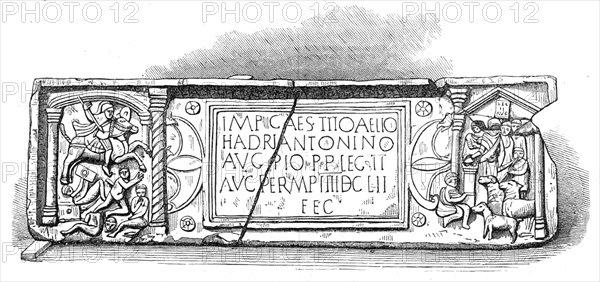
Sujet
Roman legionary tablet found at Bridgeness, Linlithgowshire, 1868. Creator: Unknown.
Légende
Roman legionary tablet found at Bridgeness, Linlithgowshire, 1868. It is well known...that when the Romans...conquered North Britain, about the year a.d. 81, they constructed a moat or ditch, and a line of forts...to keep out the Scots and Picts, the wild Celtic tribes of the Highlands. In the reign of the Emperor Antoninus Pius, about a.d, 139, a substantial wall was built, each legion of the Roman army being charged with a certain portion of the work. At each end of the allotted section a stone tablet was set up, dedicated to the Emperor, and recording the name and number of the legion, as well as the length of wall it had made...the tablet found last April, on the estate of Mr. Henry Cadell...is the finest and most complete yet discovered on the line of the Antonine Wall. The stone is 9 ft. long by 2 ft. 11 in. broad, and at each end are designs in relief, the one representing a horseman careering over several slain and wounded Britons; the other, a sacrificial scene. The inscription...is thus interpreted: "To the Emperor, Caesar Titus Aelius Hadrianus Antoninus Augustus Pius, the Father of his Country, the Second Legion, Augusta, has made 4652 paces." A Roman pace, of two steps, was about fifty-eight inches, or nearly five feet'. From "Illustrated London News", 1868.
Crédit
Photo12/Heritage Images/The Print Collector
Notre référence
HRM24A34_449
Model release
NA
Property release
NA
Licence
Droits gérés
Format disponible
8,0Mo (509,2Ko) / 20,7cm x 9,7cm / 2443 x 1150 (300dpi)